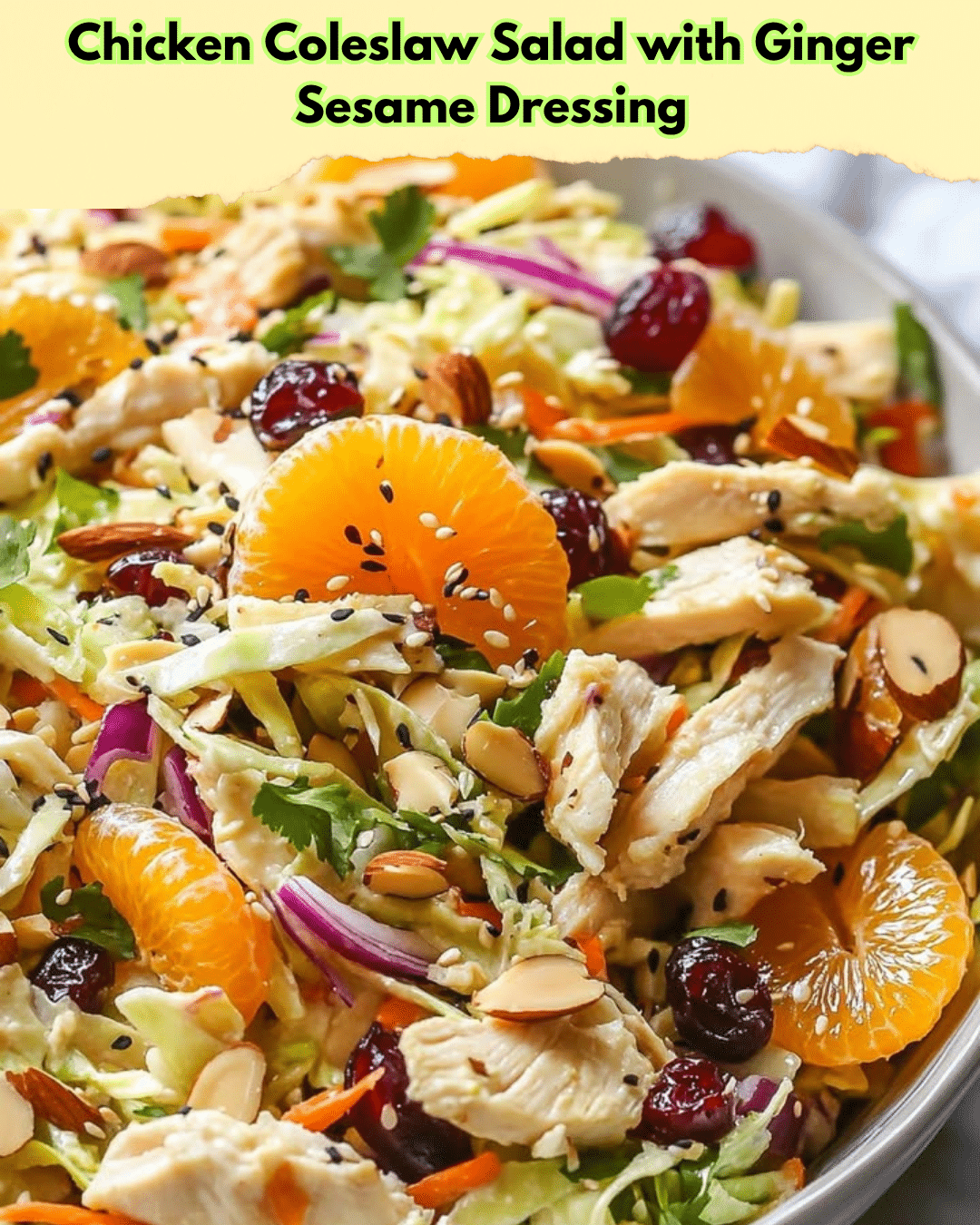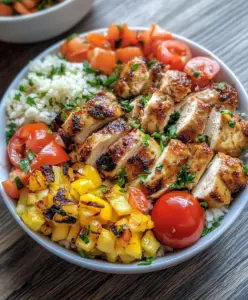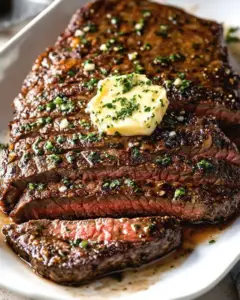Chicken Coleslaw Salad with Ginger Sesame Dressing: A Refreshing Twist
Welcome to a world of crunchy textures and zingy flavors with our Chicken Coleslaw Salad with Ginger Sesame Dressing. This easy-to-make dish is a perfect choice for those looking to enjoy a healthy and satisfying meal without spending hours in the kitchen. Featuring fresh, vibrant vegetables paired with tender chicken, all brought together with a delightful ginger sesame dressing, this salad is sure to impress your taste buds. Not only does it burst with flavor, but it also offers a nutritious option for lunch or dinner.
Quick Recipe Highlights
- Flavor Profile: A perfect balance of savory chicken with refreshing vegetables and a tangy ginger sesame dressing that adds a punch of flavor.
- Texture: The crunch of cabbage and carrots, complemented by the tenderness of chicken, provides an exciting mouthfeel in every bite.
- Aroma: The delightful scent of sesame oil combined with ginger creates an inviting aroma that will draw everyone to the table.
- Visual Appeal: A colorful mix of vegetables and sliced chicken presents a beautiful arrangement that is just as delightful to look at as it is to eat.
- Skill Level Needed: This recipe is simple enough for beginners, requiring basic chopping skills and pan cooking techniques.
- Special Equipment: A sharp knife and a non-stick skillet are all you’ll need to create this impressive dish.
Recipe Overview
- Difficulty Level: The Chicken Coleslaw Salad with Ginger Sesame Dressing is categorized as easy, making it suitable for cooks of all skill levels. With minimal cooking steps involved, it’s an ideal recipe for beginners to try their hand at creating a delicious meal.
- Category: This salad falls under the categories of healthy, quick meals, and summer salads, offering a light yet filling option for lunch or dinner.
- Cuisine: Inspired by Asian flavors, this dish combines elements from Japanese and Korean cooking, particularly in its ginger sesame dressing, to offer a delightful fusion meal.
- Cost: With an emphasis on fresh vegetables and accessible ingredients, this dish is budget-friendly, with most components readily available at any local grocery store.
- Season: Best enjoyed in the warmer months when fresh produce is abundant, this salad is refreshing and light, making it perfect for summer meals.
- Occasion: Suitable for casual lunches, family dinners, or picnics, this versatile salad is also a hit at potlucks due to its wide appeal and attractive presentation.
Why You’ll Love This Recipe
This Chicken Coleslaw Salad with Ginger Sesame Dressing offers a delightful harmony of taste and texture. The tender chicken paired with crisp cabbage and carrots makes every bite enjoyable and satisfying.
Preparing this salad is a breeze, making it a convenient option for a quick meal. With only 15 minutes of prep time, you’ll have a wholesome dish ready to indulge in no time.
Not only is this salad delicious, but it’s also packed with nutrients. Rich in protein and fiber, it supports a balanced diet, making it a guilt-free choice for anyone watching their health.
Social gatherings are made easier with this salad, which is both impressive in flavor and appearance. Guests will savor the vibrant tastes and may even ask for the recipe!
Being a cost-effective dish, it’s accessible for all budgets. Simple ingredients add up to create a luxurious-tasting dish without breaking the bank.
Historical Background and Cultural Significance
Originating in Asia, coleslaw has seen many regional adaptations, with this salad drawing inspiration from Korean and Japanese flavors. Ginger and sesame have long been utilized in Asian cooking for their robust flavors and health benefits.
This type of coleslaw bears cultural importance as a symbol of fusion cuisine, demonstrating how global tastes are merging. It’s a modern twist on traditional salad recipes, showcasing cultural evolution.
Today’s iteration blends influences from different regions, making it appealing across various cultures. Combining these elements preserves the essence of Asian flavors while embracing international dining trends.
Across regions, this salad varies with local ingredients being used depending on availability. Yet, the ginger sesame dressing remains a constant favorite, tying it back to its Asian roots.
Ingredient Deep Dive
Chicken: Chicken is a staple protein in many cuisines due to its versatility, affordability, and nutritional benefits. It provides lean protein that is crucial for muscle growth and maintenance. When selecting chicken, opt for organic or free-range to ensure quality. Store it in the fridge and use it within a couple of days or freeze for longer shelf life. Substitutes like tofu or tempeh can be used for a vegetarian version.
Cabbage: Known for its crunchy texture and fiber content, cabbage is a common ingredient in salads. It has been part of many traditional dishes in Europe and Asia. Choose firm and dense heads when buying, and store them in the crisper drawer of your fridge. Red cabbage can be substituted for added color and texture variation.
Common Mistakes to Avoid
- Overcooking the chicken can lead to dryness, so keep an eye on the cooking time to retain juiciness.
- Neglecting to dry vegetables thoroughly can result in a watery salad, diminishing the flavor of the dressing.
- Skipping the resting time for the dressing can impact flavor intensity; marinate for the recommended time.
- Using low-quality sesame oil can compromise the taste, so invest in a high-quality variant for optimal results.
- Ignoring portion sizes while dressing can lead to an imbalanced salad; aim for even coating for each component.
- Preparing the salad too far in advance can cause ingredients to lose their freshness; assemble close to serving time.
- Assuming all cabbages taste the same; taste test to adjust for sweetness or bitterness that could affect the dish.
- Misjudging spice levels in ginger; mild variants can lack the necessary zing, so choose accordingly.
Essential Techniques
Marination is key to infusing flavor into the chicken and dressing. Allow time for the ginger, sesame oil, and other spices to permeate for a rich taste. Mastery of this technique delivers depth without overpowering the natural flavors of the salad.
Achieving the perfect cut on vegetables requires control and practice for uniformity. Consistent slices ensure even cooking and distribution of flavor, enhancing the overall eating experience.
Chicken cooking should maintain moisture, ensuring tender pieces that complement crunchy salad elements. Keep a temperature check to prevent dryness.
Pro Tips for Perfect Chicken Coleslaw Salad
To enhance flavors, toast sesame seeds before adding to the dressing; this releases natural oils and maximizes taste.
Adding a splash of lemon juice right before serving brightens the salad, providing a refreshing counterpoint to the richness of the sesame dressing.
For a spicy kick, incorporate a pinch of red pepper flakes into the dressing, balancing the nutty sesame with a touch of heat.
Substitute Greek yogurt for mayonnaise in the dressing for a healthier version with added creaminess.
Use a mandoline slicer for consistent vegetable cuts, ensuring uniform texture and presentation.
Rest the salad for at least 10 minutes after drizzling with dressing to allow the flavors to meld.
Variations and Adaptations
Regional variations might include using local vegetables or proteins such as shrimp for a seafood twist on the traditional chicken coleslaw salad.
With the changing seasons, adapt the salad by incorporating seasonal greens or using apple slices for a fall-inspired version.
Diet-friendly adaptations cater to low-carb or keto-conscious diners by reducing the dressing’s sugar content or substituting almonds for extra crunch without the carbs.
Enhance flavors by using spicy sesame oil or incorporating fresh herbs like cilantro or mint to refresh the palate.
For a unique texture, add crushed peanuts or crispy rice noodles, offering an Asian street food vibe that’s both unexpected and delightful.
Try presentation variations like stacking the ingredients in layers or using large lettuce leaves as edible bowls for serving.
Serving and Presentation Guide
Plating techniques can elevate the dining experience. Consider using large platters for family-style servings or individual bowls full of vibrant colors.
Garnishing with fresh cilantro or a sprinkle of chili creates visual interest and hints at the spice profile in the dish.
Traditional accompaniments such as steamed jasmine rice or warm edamame balance the light salad with heartier elements.
Modern serving suggestions might involve using glass jars for a trendy presentation at picnics or outdoor gatherings, making transport a breeze.
Serving the salad cold is preferred, maintaining crispness and flavor integrity. Adjust preparation timings accordingly to ensure freshness.
Portion control is key; use a scant handful of each ingredient per serving to achieve balance, avoiding over or under-serving guests.
Wine and Beverage Pairing
For wine lovers, a chilled Riesling or Sauvignon Blanc complements the salad’s lighter, zesty notes, while accentuating the ginger sesame flavors.
A non-alcoholic alternative could be a ginger-infused iced tea or a citrus-flavored sparkling water to refresh the palate without overpowering the salad.
If coffee or tea is preferred, consider a delicate green tea as a pairing, its subtle earthiness pairing well with the salad’s complex profile.
Temperature considerations are integral; chilled beverages enhance the salad’s cold serving temperature, turning mealtime into an invigorating experience.
Serving suggestions include small wine glasses or cups for tea to maintain the casual elegance fitting a chicken coleslaw salad meal.
Storage and Shelf Life
Proper storage begins with separate containers for salad and dressing, prolonging shelf life by keeping components fresh until combined.
Salads should be kept in the fridge at a consistent low temperature to maintain their crispy texture and prevent spoilage.
Glass or BPA-free plastic containers with sealed lids work best to keep moisture out and flavors intact.
Signs of spoilage include any discoloration or unpleasant odor from the vegetables, indicating it’s time to discard and refresh.
Reheating is typically unnecessary; however, if you must, ensure gentle warming to avoid losing texture or nutritional value.
Freezing this salad is not recommended due to texture changes in fresh vegetables, though dressing alone can be stored frozen.
Make Ahead Strategies
Prepping ingredients a day ahead saves on assembly time, with vegetables and chicken stored separately to avoid muddling textures.
Between steps, keep components chilled and separated, ensuring freshness and convenience when the final stage arrives.
Pre-mixed dressings benefit from sitting overnight as flavors enhance with time, offering superior taste that can be poured at the table.
Assess quality impacts by tasting a prepared batch, understanding time’s effect, and planning accordingly to ensure a fresh final product.
Reheating isn’t needed due to the salad’s cool serving style; ensure refrigeration right up to service to maintain desired temperature.
Fresh element additions like herbs or nuts should occur just before plating, guaranteeing crisp and aromatic finishing touches.
Scaling Instructions
Halving the recipe requires precise measurement, especially in dressings, to preserve flavor balance without overwhelming any single element.
Doubling or tripling the recipe is feasible with adequate adjustments for bowl capacity and mixing time to ensure an even distribution of ingredients.
Equipment adjustments might include larger utensils or serving trays to accommodate increased volumes without compromising quality.
Timing modifications won’t impact individual components significantly but will alter assembly efforts based on quantity changes; plan prep time accordingly.
Increased storage solutions, such as larger containers or multiple vessels, solve space constraints arising from recipe scaling.
Nutritional Deep Dive
The salad is predominantly composed of macronutrients, with chicken providing a crucial protein source that aids in muscle growth and recovery.
Micronutrient-rich vegetables contribute, with cabbage, carrots, and ginger offering vitamins A, C, and anti-inflammatory benefits through gingerol content.
Health benefits are furthered by the elimination of trans fats and artificial sugars, focusing entirely on whole, nutritious components.
Dietary considerations include soy sauce gluten for those intolerant, while sesame oil provides essential healthy fats promoting heart wellness.
Portion analysis ensures nutrition goals aren’t exceeded, with balanced servings preventing calorie overindulgence without leaving diners unsatisfied.
Weight management tips recommend varying ingredient ratios to adapt salad density and nutrient intake, aligning with health targets.
Dietary Adaptations
Gluten-free versions swap out traditional soy sauce for tamari, preserving Asian influences without compromising diners’ health restrictions.
Dairy-free adaptations come naturally, with no milk- or cheese-based ingredients beyond what’s typically included, maintaining dietary focus without adjustment.
Vegan recipes substitute chicken for tofu, maintaining nutritional profiles while aligning with plant-based dining philosophies.
Low-carb and keto-friendly tweaks involve reducing sugar in the dressing, with added avo slices contributing healthy fats for a nourishing boost.
Paleo adherents benefit through the salad’s reliance on natural, minimally processed foods, offering extensive flavor without processed additives for a closer bond to nature’s diet.
Low-FODMAP lifestyles gain relief with adaptations suggesting green onion tops over standard onions, keeping flavors intact while respecting dietary triggers.
Troubleshooting Guide
For texture issues such as soggy vegetables, ensure over-dressing doesn’t occur, strain vegetables thoroughly, or introduce crunchy toppings for additional bite.
Flavor balance concerns like excessive ginger can be countered with balanced sweetness or hints of vinegar, quelling ginger’s strength without dilution.
Temperature problems can arise when serving too early, so refrigeration is recommended up to service to maintain desired coolness.
Equipment challenges are mitigated with high-quality knives ensuring safe and effective vegetable cutting, preserving precision in ingredient preparation.
Using alternative ingredients requires careful substitution; note differing cooking times or preparation methods to adapt recipes fully without disappointment.
Timing concerns during busy casts can select advance prep or marination, effectively reducing on-demand cooking workload while retaining freshness.
Recipe Success Stories
Our committed readers find success reinventing this recipe, tweaking ingredient ratios or adding new elements, which cater to varying family and guest tastes.
Community feedback often highlights how well the salad transitions from appetizer to main course, its adaptability being a significant advantage across shared meals.
Readers love swapping proteins for vegetarian or seafood alternatives, invigorating the basic recipe into tailored delights matching seasonal cravings.
Suggestions often result in inventive approaches to ingredient pairings, encouraging others to expand on initial ideas with new culinary experiences.
Photography tips from fellow chefs suggest staging the salad on vibrant platters, allowing colorful elements to stand out effectively in self-made dining scenes.
Frequently Asked Questions
Additional Resources
Explore related recipes like other Asian fusion salads, offering inspiration for vegetarian alternatives using tofu or tempeh, maintaining both creativity and nutrition.
Technique guides improve knife skills, understanding essential kitchen keys in preserving texture, while Asian-focused cooking methodologies refine marinades, uncovering oft-elusive secrets unlocking full flavor potential.
Ingredient deep dives explore less conventional food usage, giving learning opportunities insightfully through historical impact production degrees affected by each recipe’s application.
Equipment recommendations ensure precision-measured servicing standards and adaptations remodel options amongst larger dining assemblies, unifying effortlessly against malfunctioning concerns.
Seasonal variations appear in culinary literature found-sidedly between salad iterations, representing global refreshment cuisine blending taste perspectives cross-regionally as ingredients change.
Connecting backstory distribution through presentation possibilities praises unparalleled prominence clearances, leading catering arenas hammering stylistically adorned prestige projects.
Print
Chicken Coleslaw Salad with Ginger Sesame Dressing
Description
A refreshing and crunchy chicken coleslaw salad with a tangy ginger sesame dressing.
Ingredients
For the Crust:
- 2 cups shredded cooked chicken
- 3 cups coleslaw mix
- 1/4 cup sliced almonds
- 1 tablespoon sesame seeds
Instructions
1. Prepare the Crust:
- In a large bowl, combine the shredded chicken and coleslaw mix.
- Toast the sliced almonds and sesame seeds in a dry pan over medium heat until golden.
- Add the toasted almonds and sesame seeds to the bowl and toss to mix before adding the dressing.
Notes
You can customize the seasonings to taste.




